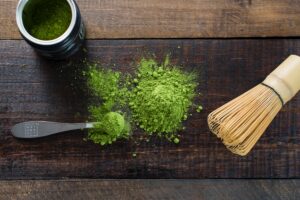All About Matcha
What is Matcha?
In fact, the word Matcha comes from Japanese: “ma” translates to rubbed or ground, while “cha” means tea.
If you’re not familiar with matcha, it’s a Japanese green tea powder made from finely powdered dried tea leaves. It has a slightly bitter, vegetal taste and a vibrant green color that results from the leaves’ high chlorophyll levels. Matcha is picked from the youngest, freshest and finest leaves are used; which boasts the most nutritional value out of all green teas. Rich in nutrients, antioxidants and fiber, matcha is highly touted for its health benefits. It’s been the cornerstone of traditional Japanese tea ceremonies for centuries, but it recently became popular in the US because of its health benefits.
Regular green tea is already touted as an antioxidant powerhouse, but matcha has even more benefits. Here’s why: when you make other forms of green tea, you steep the leaves in hot water and then discard them. When you make matcha, you whisk the powder into hot water or milk. As a result, you actually consume the entire tea leaf when you drink it! This is why matcha is 10 times stronger than a regular cup of brewed green tea, delivering the full force of a green tea in every concentrated sip. The antioxidants it contains may lower blood pressure, reduce your risk of heart disease, and even boost your metabolism.
So what about caffeine? Well, matcha does contain more caffeine than regular green tea, but it doesn’t give you a buzzy rush like coffee. It leaves me feeling energized and focused, but still calm.
Not all matcha is created equal. Buying matcha for the first time can be confusing – there are so many brands, and they vary widely in quality. I always advocate looking for one with no added sugar. Beyond that, the most significant distinction is between ceremonial and culinary grade matcha. The ceremonial kind will be pricier – it’s made from the youngest tea leaves and has a mellow flavor. Choose it if you plan to drink your matcha with just water.
It doesn’t last forever. Matcha doesn’t have a particularly long shelf life. Once you open it, use it within 2 months for the best color and flavor. I recommend buying it in small quantities and storing it in the fridge to preserve freshness.
You might want a matcha whisk. If you make matcha often, I recommend investing in a bamboo whisk called a chasen (check our online store). Its special design breaks up clumps and creates a frothy layer of foam on top of the tea. If you don’t have one, use a regular whisk or an electric milk frother instead. Whisking or stirring with a fork or spoon will not work here.
Is There A Traditional Time To Drink Matcha?
Matcha can be enjoyed anytime, though we recommend drinking it earlier in the day to benefit from its sustained energy boost.
What Should Matcha Taste Like?
It has the perfect balance of a crisp sweetness with a grassy and umami finish.
Does Matcha Have Any Health Benefits That Other Green Teas Don’t?
With loose leaf teas, the leaves are steeped and then discarded. With matcha you get the benefit of the full vitality of the tea leaf, since you’re consuming ground tencha leaves (that have had the stems and veins removed). Matcha contains vitamins A and C, dietary fiber, and potassium. It also contains EGCg, a special kind of free-radical-fighting flavonoid and antioxidant that is associated with cardiovascular health and weight loss.
Matcha delivers an invigorating boost of energy and nutrients, with a “calm alertness” attributed to an amino acid called L-Theanine. It is known to give mental clarity and a heightened awareness. The calm of the L-Theanine, helps counter the jitters that caffeine often gives, and only has 1/3 of the caffeine content of coffee.
Matcha Green Tea Latte Recipe (Hot or Iced)
Wake up in the morning with a rejuvenating, nutritious matcha latte. This fast and easy recipe compliments and offsets the fragrant, leafy taste of matcha green tea powder with creamy milk and a little sugar for a flavour balance that will leave you feeling ready and raring to go. Delicious hot or cold.
Ingredients
• ¼ teaspoon matcha powder latte
• 2 ounces boiling water
• 6 ounces additional boiling water or steamed milk of choice, almond milk, oat milk, coconut milk, dairy milk, etc.
• Maple syrup, honey, or other sweetener, optional
Directions
• Sift the matcha into a mug or small bowl to get rid of any lumps.
• Pour in the 2 ounces boiling water. Using a matcha whisk or small regular whisk, whisk briskly from side to side until the matcha is fully dispersed and there is a foamy layer on top.
• Add the remaining 6 ounces boiling water or steamed milk and whisk again until foamy. Sweeten to taste, if desired.
Ceremonial Matcha Recipe
Ingredients
- 1 teaspoon Matcha ceremonial grade green tea powder
- 1 cup hot water (not quite boiling – 165°F to 180°F)
Directions
- Clean all of your utensils well, then scoop the matcha into a bowl or cup.
- Ladle, or slowly pour, the hot water on top of the matcha.
- Using a traditional bamboo matcha whisk or a handheld electric milk frother, whisk the mixture until a light foam covers the top.
- If desired, add a natural sweetener like honey, stevia or agave.

